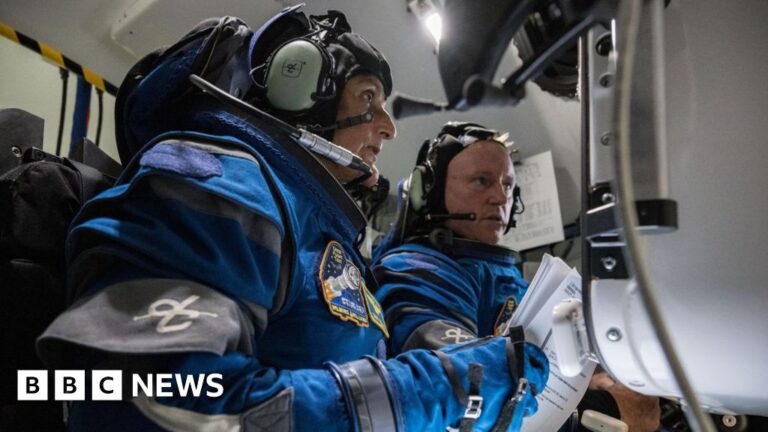The two astronauts testing Boeing’s new Starliner spacecraft were scheduled to begin their return to Earth on Wednesday night, but will instead remain aboard the International Space Station (ISS).
The spacecraft’s return to Earth had already been delayed because of problems with some of its thrusters and a leak in the helium gas that fuels its propulsion system.
NASA is conducting a high-level review of technical issues before deciding when to return astronauts.
Suni Williams and Butch Wilmore are not in any danger, but what happened to the spacecraft, and what does this mean for their return?
Starliner launched on June 5 despite a small leak of helium gas, which is used to fuel the thruster system used to maneuver through space and slow the spacecraft for re-entry into Earth’s atmosphere.
The leak was so small that engineers believed it would not affect the mission and so the launch continued.
However, there were four further helium leaks during the mission, and five of the 28 maneuvering thrusters shut down during the approach to the space station, although four of them were later restarted.
The mission was scheduled to last eight days, but the return date was postponed while engineers investigated the problem.
Then, on June 18, NASA announced that Starliner would begin its return journey at 10:00 PM Eastern Standard Time on Wednesday, June 26 (3:00 AM BST on Thursday, June 27).
NASA previously said in a blog post that the leak does not pose a safety risk to astronauts because “a typical end-of-mission period requires only seven hours of free flight, and Starliner’s tanks currently have enough helium remaining to support 70 hours of post-undock free-flight operations.”
But just days later, after a high-level meeting, NASA concluded that the planned return should be “adjusted” to July, without providing further information about why the decision was changed.
NASA said it wants flight engineers to examine the spacecraft to determine what went wrong before it re-enters the atmosphere. That’s because the crew capsule will parachute back to Earth, but Starliner’s failed lower “service module” will burn up during re-entry, meaning some information about what went wrong will be lost.
The space agency stressed that no astronauts were left behind and that Starliner remains eligible to return to Earth in the event of an emergency on the ISS.
What happens next will be determined by a high-level “agency-level review” by NASA.
The series of events raises questions about whether the launch should have gone ahead despite the leak.
Adam Baker, president of Rocket Engineering, a British company that specializes in rocket propulsion systems, said he understood why the launch went ahead but would have preferred if the cause of the leak had been identified and repaired.
“When you try to get things too perfect, you risk taking too long, costing too much, and losing public and political support as a result,” he said.
“But my feeling is that they may not have fully considered the worsening of the leak after launch, which is probably something NASA and Boeing should have done.”
That would have been hugely expensive, as it would have required removing the rocket from the launch pad and detaching the propulsion system from the spacecraft.
Another question in NASA’s investigation, according to Dr Simeon Barber, a space scientist at the Open University, is why these issues were not identified during either of Starliner’s two previous unmanned test flights.
“The issues we’ve seen in recent weeks are of a nature that we would not have anticipated at this stage in the Starliner program,” he said.
“The purpose of this project was to test how involving astronauts in controlling the spacecraft would affect performance. But it appears we’re actually addressing more fundamental problems that should have been solved by now.”
Finally, NASA has the critical issue of identifying the root cause of the helium leak and thruster problems. Until that’s done, Dr. Barber says, all risk analyses and contingency plans for the safe return of astronauts will remain incomplete.
“Until the root cause is understood, we must make decisions about our return based on incomplete information. Without a full understanding of the cause of the failure, we cannot be certain that there isn’t a systemic issue affecting not only the main propulsion system but also the backup.”
As a last resort, NASA and Boeing could return astronauts on SpaceX’s Dragon spacecraft, which would be very embarrassing for Boeing, but Dr Baker says we’re not there yet.
“With any new spacecraft, you have to be prepared for the unexpected,” he said. “This was a completely expected failure, and I don’t see it as a major concern, other than it will need to be analyzed and fixed before the next crewed flight.”

